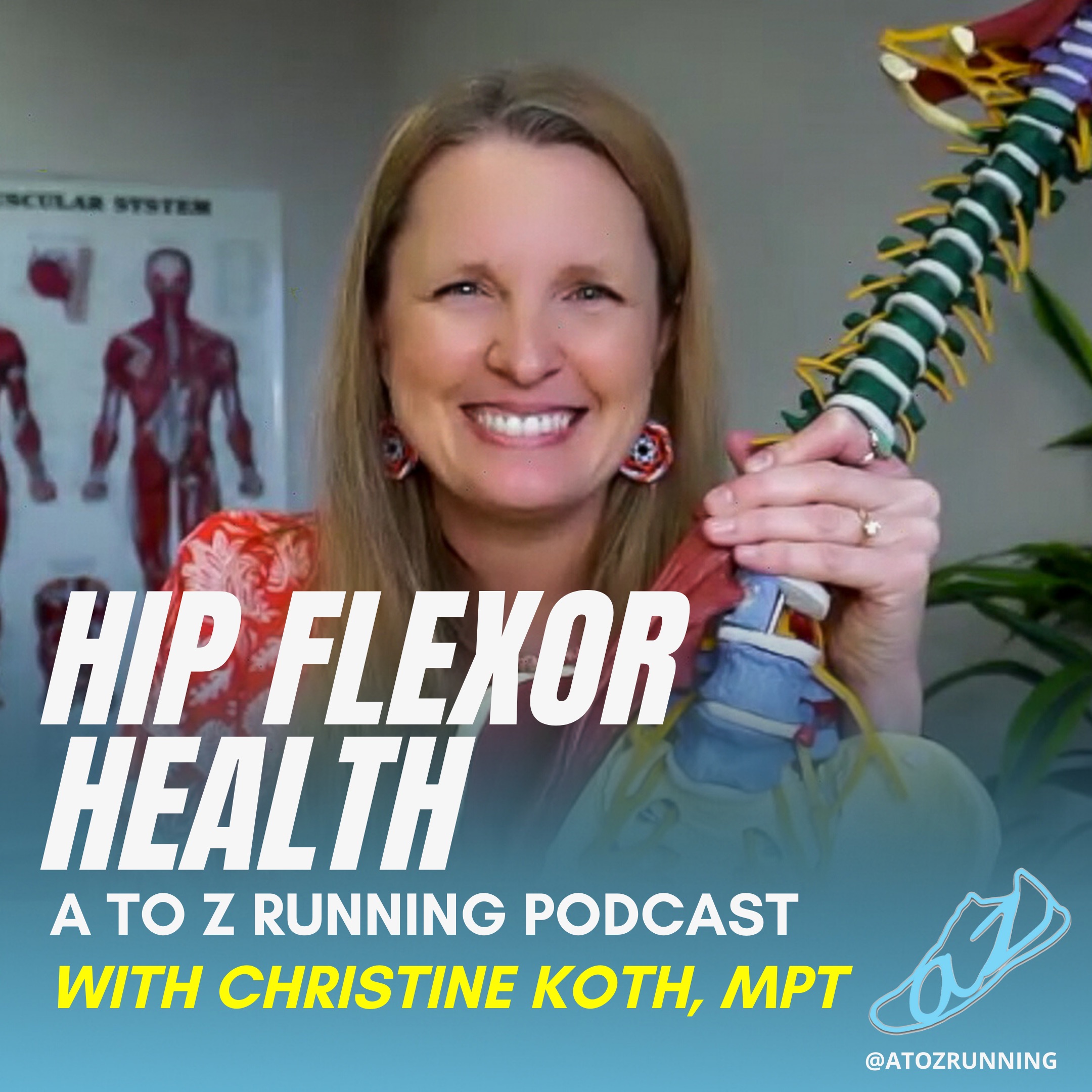LISTEN
Hip flexor health can feel elusive to some runners. Injury, tightness, and other pain stemming from the hip flexor region are problematic. On the show today, Christine Koth, physical therapist, author, and hip specialist discusses how those hip muscles work and how to keep them healthy.
INTRO
-
-
- FOLLOW and SUBSCRIBE
- Thanks for joining in on the conversation on social media.
- Check out our article with gift ideas, Gifts for Runners!
-
MAIN TOPIC: HIP FLEXOR HEALTH
Main Topic: Hip Flexor Health
Today on the A to Z Running podcast we dive into why runners often have hip flexor issues and what we can do about it. To help us explore and learn about this topic, we’ve invited Christine Koth, MPT.
About our Guest: Christine Koth
Christine Koth, MPT, is the bestselling author of the book Tight Hip, Twisted Core: The Key to Unresolved Pain, CEO/Cofounder of Aletha Health, and inventor of both the Hip Hook and the NUCKLE. With over 20+ years of clinical practice as a holistic physical therapist, her years of research into the iliacus muscle has led her to develop the Un:Tight Method, focused on reducing muscle tension in the primary and secondary core.
Follow Christine Koth’s work:
Facebook: @alethahealth
Instagram: @christinekoth and @alethahealth
Website: shop.alethahealth.com
You can buy the hip hook HERE.
Use the discount code: AtoZ
(Disclaimer: this is an affiliate code.)
WORLD OF RUNNING
#1. High School cross country race with all the records was short.
- Garmin RunningLane Cross Country Championships was speculated to be on a short course
- One coach, Dr. Neal Baumgartner who is also the Chief of the US Air Force Exercise Science Unit measured the course at 4935, taking all the tangents.
- “There is no official standard for measuring, certifying, verifying, or justifying a high school or college cross country course or record for that matter,” Allan says. “There are simply best practices, which we have followed.”
- “There will never be real credibility for any XC record from course to course until the courses are measured the same way,” Katz writes. “You can disagree until the cows come home but this is fundamental for records. And that my friends is one of the reasons why there are no USATF or World Athletics cross country records.”
#2. Jakob Ingebrigsten on having a normal life
- Jakob told his father and coach Gjert, “I can quit today. The only way to be at my best is to have a normal life.”
- “His life is very normal,” Gjert told Wisner. “He doesn’t have any blind spots or empty spaces in his life. He has his fiancé and his dog and his own apartment and his own life. He doesn’t feel like he’s missing anything. I think that’s a part of sustainability. You have to live as close to a normal lifestyle as you can while still being focused.”
- “Maybe I’ll run for another year,” Jakob has told his father. “Maybe I’ll run for two years. I don’t know. I can’t see myself running in 10 years. I will do something else with my life.”
#3. Research on Marathon Racing Shoes
(The Biomechanics of Competitive Male Runners in Three Marathon Racing Shoes: A Randomized Crossover Study, Wouter Hoogkamer, Shalaya Kipp, Rodger Kram
Author links open overlay panel
Clarissa S. Whiting, Wouter Hoogkamer, Rodger Kram)
- Biomechanics study:
- We have shown that a prototype marathon racing shoe reduced the metabolic cost of running for all 18 participants in our sample by an average of 4%, compared to two well-established racing shoes. Gross measures of biomechanics showed minor differences and could not explain the metabolic savings.
- Results showed that hip and knee joint mechanics were similar between the shoes, but peak ankle extensor moment was smaller in NP versus AB shoes. Negative and positive work rates at the ankle were lower in NP shoes versus the other shoes. Dorsiflexion and negative work at the metatarsophalangeal (MTP) joint were reduced in the NP shoes versus the other shoes. Substantial mechanical energy was stored/returned in compressing the NP midsole foam, but not in bending the carbon-fiber plate.
- Conclusion of biomechanics study: The metabolic savings of the NP shoes appear to be due to: (1) superior energy storage in the midsole foam, (2) the clever lever effects of the carbon-fiber plate on the ankle joint mechanics, and (3) the stiffening effects of the plate on the MTP joint.
- Metabolic costs on level, uphill, and downhill running
- Compared to the conventional shoes (Streak 6), the metabolic power in the Vaporfly 4% shoes was 3.83% (level), 2.82% (uphill), and 2.70% (downhill) less (all p < 0.001). The percent of change in metabolic power for uphill running was less compared to level running (p = 0.04, effect size, ES = 0.561) but was not statistically different between downhill and level running (p = 0.17, ES = 0.356).
- Conclusion
- On a running course with uphill and downhill sections, the metabolic savings and hence performance enhancement provided by Vaporfly 4% shoes would likely be slightly less overall, compared to the savings on a perfectly level race course.
Interested in a training plan and/or coaching? We offer personalized support to help you achieve your goals!




Leave a Reply
Want to join the discussion?Feel free to contribute!